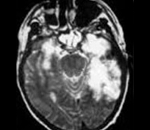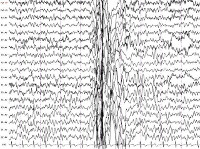Category: Myoclonus
Objective: Since the treatment of subacute sclerosing panencephalitis (SSPE) is difficult and prognosis if often fatal and therapy is problematic the goal of this research was to study antibodies against measles virus (MV) and glutamic acid decarboxylase 65-kilodalton isoform (GAD65) in order to neutralize possible target in possible treatment options.
Background: Opsoclonus is characterized by involuntary, arrhythmic, chaotic, multidirectional saccadic eye movements with horizontal, vertical, and rotatory components; it is usually accompanied by cerebellar ataxia and myoclonic convulsions of the muscles of the trunk and extremities. This is a rare neurological disorder of unknown cause, which is likely the result of autoimmune processes associated with the nervous system.SSP is a progressive, often fatal brain disease that usually begins years after measles. It causes mental degradation, myoclonic convulsions and convulsions. Electrooculography is a method designed to study nystagmus. This method is based on graphic registration of the movement of the eyeballs. Nystagmography helps to determine the frequency of eye movement and oscillatory nystagmoid movements.
Method: We studied anti-GAD65 and anti-MV antibodies in 19 SSP patients, men and women from 14 to 52 years old demonstrated symptoms of opsoclonus and 27 healthy donors by the same age groups, employing Western blot analysis. MRT, EEG and electrooculogram (EOG) were used for evaluation of all patients.
Results: We found that GAD65 and anti-MV AB were raised in 14 SSPE patients and only in 4 participants of control group. EEG showed spike waves more often in the left temporal lobe of 15 patients and 7 donors EOG demonstrated nystagmus in 17 patients and 5 donors. EEG also showed periodic complexes with high-voltage biphasic waves occurring synchronously throughout the recording. MRI revealed cortical atrophy.
Conclusion: The neurological complication of a viral infection in the form of SSPE makes one think about the choice of suitable targets for pharmacological action. In this sense, the clear presence of antibodies to the measles virus and GAD65 and their mutual and competitive synthesis provide ideas for a new drug effect.
References: 1. Garg RK, Mahadevan A, Malhotra HS, Rizvi I, Kumar N, Uniyal R. Rev Med Virol. 2019 Sep;29(5):e2058. doi: 10.1002/rmv.2058
2. Mekki M, Eley B, Hardie D, Wilmshurst JM. Dev Med Child Neurol. 2019 Oct;61(10):1139-1144. doi: 10.1111/dmcn.14166
3. Update on opsoclonus-myoclonus syndrome in adults.Oh SY, Kim JS, Dieterich M.J Neurol. 2019 Jun;266(6):1541-1548. doi: 10.1007/s00415-018-9138-7.
To cite this abstract in AMA style:
D. Labunskiy, S. Kiryukhina, V. Podsevatkin. Opsoclonus-Myoclonus Syndrome in Subacute Sclerosing Panencephalitis: Antibodies and Cytokine Response [abstract]. Mov Disord. 2022; 37 (suppl 2). https://www.mdsabstracts.org/abstract/opsoclonus-myoclonus-syndrome-in-subacute-sclerosing-panencephalitis-antibodies-and-cytokine-response/. Accessed March 31, 2025.« Back to 2022 International Congress
MDS Abstracts - https://www.mdsabstracts.org/abstract/opsoclonus-myoclonus-syndrome-in-subacute-sclerosing-panencephalitis-antibodies-and-cytokine-response/


